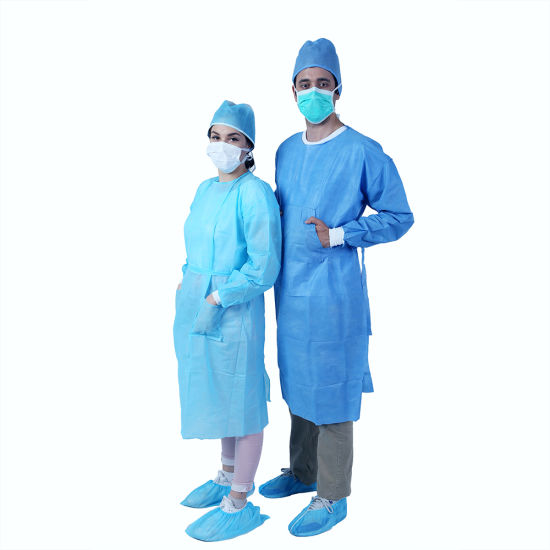
Infection prevention is a key issue for both the patient and the health care provider. To decrease the risk of cross-infection, non-woven disposable gowns are used in surgical environments to provide barrier protection against fluid, particles, and microorganisms. Surgical gowns should be breathable to ensure that patients are comfortable.
When non-woven disposable gowns and drapes are utilized during general surgical procedures, the post-operative infection risk is significantly reduced. In developed countries like the United States, where 80 percent of surgical gear is single-use, disposable products also minimize the risk of wound infection. These non-woven disposable gowns are often employed as a composite. They are sterile, soft, antibacterial, liquid repellent, and liquid absorbent. The non-woven disposable gown can be constructed of natural fibers such as cotton, linen, and wood pulp, as well as man-made materials such as polypropylene, polyester, nylon, polyethylene, glass, and polytetrafloroethylene for medical applications
Surgical robes are now designed to facilitate a wide range of operations. The price of a gown is determined by the level of protection it provides. Non-woven Disposable gown have the advantage of allowing the hospital to rapidly dispose of contaminated textiles. Gowns that fit properly are more efficient in eradicating hazardous illnesses. It must be able to move freely without friction and be resistant to ripping.
The standard divides gowns and other protective clothing designed for use in healthcare institutions into four categories of barrier protection. Because product names are not standardized, it is critical for the user to choose their gown by examining unique gown labels for the intended usage and desired degree of protection based on the risk levels listed below:
Level 1: Low risk, to be utilized in situations such as basic care, routine isolation, visitor cover gowns, or in a regular medical unit.
Level 2: Low-risk, for use during blood draws, suturing, in the Intensive Care Unit (ICU), or in a pathology lab, for example.
Level 3: Moderate risk; for example, during an arterial blood draw, the insertion of an intravenous (IV) line, in the Emergency Room, or in trauma situations.
Level 4: High-risk, for use during long, fluid-intensive procedures, surgery, or when non-airborne pathogen resistance is required when infectious illnesses are anticipated.
Our Non-woven Disposable Surgical Gown includes the following features:
· Protection: To guarantee the safety of HCW and patients, this surgical gown protective garment must fulfill the minimum performance criteria for strength, barrier protection, and fluid resistance.
· Hygiene: It improves infection prevention while also lowering the risk of cross-contamination. Infection prevention is essential for good hygiene. Disposable Personal Protective Equipment (PPE) is an important part of any facility’s infection control operations.
· Comfort: Today’s surgical gowns worn by physicians, nurses, patients, and other healthcare workers should give adequate comfort while doing their duties at the hospital. Comfort is the factor that causes a person to become more concentrated on his or her task.
· Fabric Characteristics: Disposable surgical gowns should be made of high-quality fabric to ensure the surgical team’s comfort. The surgical team must work all day throughout the surgery, therefore it is the manufacturer’s responsibility to pick skin-friendly gear so that they may operate without complaint.
What are the Benefits of Non-woven in Medical Applications?
Non-woven have a long history of meeting the unique needs and expectations of medical environments, thanks to the following characteristics:
· Exceptional effectiveness and efficiency
· Excellent performance (vapor transmission, air permeability, comfort, feel, etc.)
· Excellent barrier-building capacity
· Excellent user security (high tearing & abrasion resistance, etc.)
· Cross-contamination prevention that works
· Incomparable wound care (absorbent pads, drug-delivery devices, bandages, etc.)
· Usage in ICUs, laboratories, and operating rooms is well established.
.
In surgery and medicine, nonwoven disposable gown have become indispensable; the variety of applications for this material demonstrates its amazing versatility and adaptability. It may appear that the items made feasible by this technology are just for the technologically savvy. However, that image conceals the fact that everyone will profit from this technology at some time. Nonwoven disposable gown, then, aren’t only something the medical sector should be grateful for; they’re something that everyone should be grateful for.